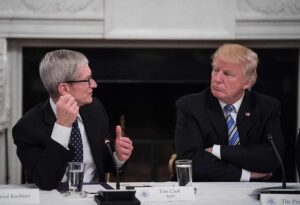iphone exports:
Whether it’s in your pocket or on your wish list, the iPhone is everywhere. It’s sleek, powerful, and now more than ever, made in India. Over $22 billion worth of iPhones were manufactured in India last year alone. And exports were the record-breaking 1.5 trillion rupees. That’s $17.4 billion worth of iPhones shipped to the world from India in just 12 months. But not everyone is happy. U.S. President Donald Trump is now threatening to slap 25% tariffs on iPhones made outside the United States.

A direct shot at Apple’s growing India strategy. So why is Apple betting big on India? And what happens if Trump follows through?
Let’s break it down. On May 23rd, President Trump posted on Truth Social declaring that Apple must manufacture iPhones in the U.S. or face a minimum 25% tariffs. This came after he previously said that he did not want Apple to build in India. He later confirmed that Samsung and other phone makers would also be included in the tariff list, with measures expected to take effect by the end of June.
Trump’s post came just months after Apple announced a $500 billion investment in the United States. But despite that pledge, Trump wants more, and he’s drawing a red line around India. On the day of the announcement, markets reacted instantly. Apple’s stock reportedly fell 3 percent following the post. Analysts warn that iPhone prices in the U.S. could surge from $1,000 to as high as $3,500 if production is forced back to America.
Right now, it would be considerably more expensive to make an iPhone in the U.S. With today’s technology, today’s facilities, and today’s U.S. skill level in the labor force, it would be considerably more expensive to build in the United States. So why is Trump pushing back so hard? Let’s break that down. For over a decade, Apple produced more than 90 percent of its iPhones in China.
But the tide is turning. Trade uncertainties, costs, and strategy are driving a shift. Apple now wants to make 25 percent of global iPhones in India within a few years, and most U.S.-bound iPhones in India by the end of next year. And that transformation is already underway.
Vikram Misri
“Electronic exports have increased more than six times. So this is production CAGR is 17 plus percent and export CAGR is 20 plus percent. Within a short time frame, the ecosystem, which means the components manufacturers and the diversity of the manufacturing ecosystem in the country has substantially increased.”
So what’s driving India’s export boom? Why is Apple so all in on India?
The reasons are quite clear. India offers labor costs reportedly as low as $2 per hour. Its workforce is young, skilled, and growing. Factory setups in the country currently cost a fraction of that in the U.S. The government is offering generous subsidies through the Production Link Incentive, or the PLI scheme. Besides, India is making significant improvements in port infrastructure, and offers low domestic transport costs, making it attractive for export-oriented production.
Such investments have pushed Apple’s top supplier, Foxconn, to invest $1.5 billion more in the Indian state of Tamil Nadu to expand its display module plant. Under the PLI scheme, Foxconn reportedly got nearly $295 million in 2023-24 alone. Even major domestic players like Tata Group have joined the momentum, acquiring Wistron’s India is positioning itself as a global manufacturing powerhouse, and Apple wants in, regardless of tariffs.

If President Trump follows through with his threat, a 25% tariff on iPhones manufactured outside the U.S. could hit American consumers first. Unless Apple absorbs the cost or passes it down its supply chain, iPhone prices in the U.S. could skyrocket.
But the impact wouldn’t stop there. The tariffs could ripple through Apple’s business model, leading to possible US job cuts, as well as a major hit to the company’s market valuation. And moving manufacturing back to the US? It’s easier said than done. Apple currently assembles only the Mac Pro and selects server equipment in the US. iPhone production is far more complex, and relocating it would be costly, slow, and high-risk. In fact, Apple’s shift to India wasn’t just about cost.
It was about speed, scale, and supply chain resilience. Assembling an iPhone in India reportedly costs between $15 and $25 per unit. In the United States, it costs $70 to $85. And that’s just the start. Setup costs, workforce training, and domestic component supply make the US option a multi-year, multi-billion dollar gamble.
We’ve had globalization now for decades, and it’s enabled products to be made a lot cheaper for American consumers. Now, if you are starting to bring back production to the United States, it will mean that the price of making these products increases, because wages are higher in the United States than in many other parts of the world, and it is going to take a considerable amount of time for production bases and factories to be mottled in some parts of the world and rebuilt in America.
This is why India remains crucial, not just for Apple, but for the future of electronic supply chains. President Trump may want iPhones built in America, but the reality is, the factories, incentives, and skilled labor are already in India. And that’s where the next chapter of tech manufacturing is being written.
